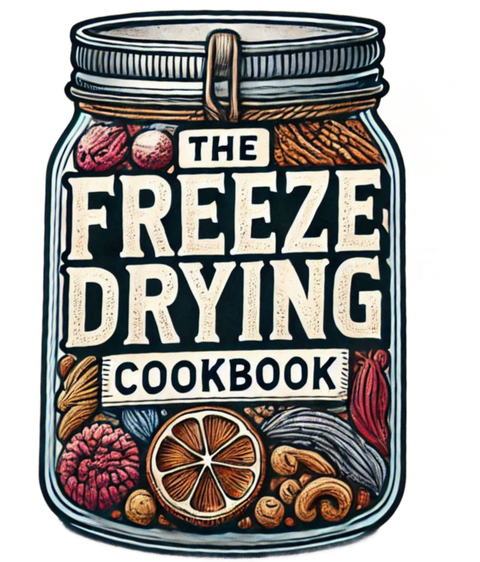The Basics-What to Know Before Using Our Cookbooks and Recipes
1. Understanding the Freeze-Drying Process
Freeze drying removes moisture from food through sublimation, turning ice directly into vapor without passing through a liquid stage. This preserves food for long-term storage while retaining its original taste, shape, and nutrients.
2. Key Factors Affecting Freeze Drying
Several variables influence freeze-drying times and results:
- Pre-Freezing: Most foods benefit from pre-freezing, which can speed up the process and improve texture. If you have freezer space, use it since it is running anyway.
- Proper Spacing on Trays: Spreading food evenly prevents overloading and ensures efficient drying.
- Moisture Content: Foods with high water content take longer to freeze dry.
- Ambient Conditions: Humidity and room temperature can affect drying efficiency.
- Food Thickness: Thinner slices dry faster than thicker ones. Increase the amount of surface area exposed to sublimation for faster cycles.
- Hi Fat Foods: Items such as hamburger that are high in fats will not store long term unless some key steps are taken.
- Choose lean cuts of meat
- Drain the excess fat after cooking
- Rinse the meat twice through in a colander with HOT water
- Seeds: Foods such as raspberries and strawberries have small seeds that tend to retain moisture. It is recommended to run the freeze drying cycle another 8 hours past the time the food is considered dry to pull moisture from the seeds.
3. Storage Tips
Properly bagging your food immediately after it comes out of the freeze dryer is crucial to maintaining its long-term quality. Freeze-dried food is highly hygroscopic, meaning it quickly absorbs moisture from the air, which can lead to spoilage, texture changes, and reduced shelf life. To prevent this, transfer food directly into Mylar bags with oxygen absorbers, vacuum-sealed jars, or airtight containers as soon as it finishes drying. Delaying this step, even by a few minutes, can allow humidity to seep in, compromising the crispness and preservation of your food. By sealing your freeze-dried goods right away, you ensure maximum freshness, flavor, and longevity for years to come.
4. Cycle Times and Rehydration Methods
The information provided in these recipes serves as a general reference, but keep in mind that many factors influence freeze-drying times and rehydration ratios. Variables such as food type, thickness, and freeze dryer settings can affect the process. While these guidelines can be helpful, your results may not always match the times and rehydration amounts listed in the cookbook. As a best practice, start with a lesser amount of water when rehydrating and gradually add more as needed.
5. Freeze Dried Pantry Recipes
Any recipe that has - Freeze Dried Pantry behind it, uses already freeze dried ingredients. If you do not already have these ingredients freeze dried, your intention in using the recipe will need to be considered: are you making a meal to eat right now and have the same ingredient fresh? Are you working on making MRE’s or Meals in a Jar? The answer to those questions will determine how you should proceed with altering or using the recipe.
6. Converting Our Recipes to Your Freeze Dryer Size
We designed this cookbook to be compatible with any freeze dryer, making it easy to adjust recipes based on your machine’s capacity. To simplify calculations, when possible or applicable we list yields in cups per recipe, allowing you to scale the batch size to fit your trays.
For example, if a recipe yields 6 cups, and your tray holds 6 cups, but you want to fill 5 trays, you would need to multiply the recipe by 5 to ensure you have the right amount. This approach makes it easy to adapt recipes to match your specific freeze dryer tray size. See our freeze dryer capacity page in the Downloadable Items on this page for information about the capacity of your freeze dryer trays. Use this information to adjust any recipe to fit your freeze dryer trays.
7. Most Importantly
Just like in cooking, individual results will vary. Factors such as ingredient brands, precise measurements, ambient temperature, and humidity can all impact freeze-drying and rehydration outcomes. As you experiment, take note of patterns in different recipes, recognize what adjustments may be needed, and enjoy the process. Over time, you’ll develop the skills to modify your favorite recipes for optimal freeze-drying results.
8. Experiment and Have Fun!
Just like traditional cooking, freeze drying is a learning experience. As you try different recipes, take notes on what works best, adjust water ratios for rehydration, and enjoy the process of creating long-lasting, delicious meals.
Buy our hard copy or PDF cookbooks here


Comments (0)
There are no comments for this article. Be the first one to leave a message!